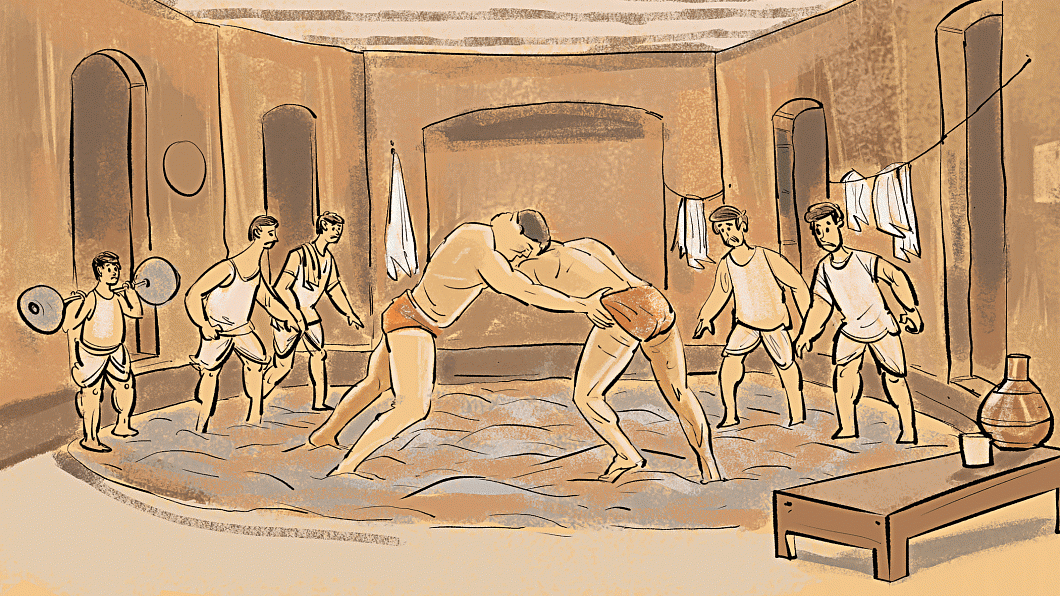Remnants of a wrestlers’ nest
Kushti, also known as pehlwani, a form of traditional wrestling contested in the sub-continent, was once a popular sport in Dhaka after having originated during the Mughal period.
Not only concerned with the physical aspects, kushti had once played a major role in moral teaching while also garnering significant political attention.
There are some publications which ties Dhaka and kushti in great details, most notably: Hakim Habibur Rahman's Dhaka Pachas Baras Pahle (Dhaka Fifty Years Ago), Munshi Rahman Ali Tayesh's Tawarikhe Dhaka (History of Dhaka), and Nazir Hossain's Kingbadantir Dhaka (Dhaka of legends).
Sadly, it appears that kushti is all set to disappear from the sporting landscape of Dhaka and will only reside in pages of history books.
FLASHBACK TO THRIVING TIMES
According to researchers, the training place of the game was termed as Akhara -- derived from the Sanskrit word Akshabat, according to historian Sirajul Islam. Akhara originally meant marshland or sports ground but later expanded to mean wrestling venues, moral and physical training centres.
Vaishnava music centres and saints also used to build Akhara as their abode and centre of spiritual excellence. Swadeshi movement activists and others used this institution extensively during the second decade of the 20th century.
Ideally, the kushti arena -- made with red clay through a special process called Phalka -- was lowered from ground level and at least one-and-a-half feet of red soil was laid on it. Oil, ghee (clarified butter) and mathha (a beverage made with buttermilk or yoghurt) were poured on the area for months.
Hashem Sufi, a researcher and resident of old Dhaka, said that the wrestling stadium in Sadarghat was one such arena during the Mughal period.
Sufi said that during the Mughal period, there was a custom of making wrestling training fields in open areas in Dhaka. Also, the end of the British rule saw some wrestling arenas established in different neighbourhoods by the initiative of the revolutionaries. In those places, wrestling boards were installed inside buildings.
Apart from the regular training and practice, various types of kushti competitions were held here throughout the year. Habibur, in Dhaka Pachas Baras Pahle, wrote: "I saw in my childhood that Hindus, Muslims, Armenians, rich or poor, all had more or less passion for exercise and wrestling in Dhaka."
Apart from the regular training and practice, various types of kushti competitions were held here throughout the year. Habibur, in Dhaka Pachas Baras Pahle, wrote: "I saw in my childhood that Hindus, Muslims, Armenians, rich or poor, all had more or less passion for exercise and wrestling in Dhaka."
During the Pakistan regime, the then Dhaka Municipality built a wrestling stadium and a fitness centre on the banks of the Buriganga River -- adjacent to the north side of the Buckland Dam between Ladies Park and Northbrook Hall -- to keep the environment of sports and art-culture practice and leisure intact.
It is learnt from Kingbadantir Dhaka, and researchers including Sufi, that the wrestling stadium and fitness centre, then known as Quaid-e-Azam Physical Training Institute, was built in Sadarghat in 1949. After the independence of Bangladesh, the name was changed to Nabajug Fitness Centre.
Tayesh's book, Tawarikhe Dhaka, reveals that back in the day, people were very much interested in kushti and strength-training. It is also mentioned, Churihatta, Farashganj, Armanitola, Bakshibazar, Becharam Deuri had great fame for these sports.
Many old Dhaka citizens can still remember the Urdu film Bhayya, directed by Kazi Zahir and released in 1966, which was shot at the Sadarghat wrestling stadium during the Pakistan period. The film featured the protagonist, played by Shoukat Akbar, involved in kushti duel.
The main annual festival of kushti in Dhaka took place in the month of Muharram, as displays of various physical feats buzzed in the heart of Old Dhaka throughout the night. It is known that this practice was prevalent even in the last part of the British period.
Haji Ibrahim Tayamia Palawan, a veteran wrestler of Bangshal, said that during the Pakistan era, kushti competitions were held every year on the occasion of Independence Day. Even after the Liberation War, kushti matches were held for a few years.
He told The Daily Star that in the sixties, kushti was practised in Bangshal, Nazirabazar, Suritola, and so on. The main centre of kushti practice in Bangshal was the Millat Gymnasium, located at the Abdullah Sarkar Lane on the northwest side of the Bangshal pond.
The kushti arena in Suritola, next to Bangshal, was also famous. Hamid Palawan managed the arena. Several of Hamid's disciples, including Ibrahim Palawan, rose to fame as wrestlers.
Asiya Khatun, wife of Ibrahim Palawan, witnessed a kushti tradition within her father's and husband's family. In the 1960s, she saw Suritola regularly stage wrestling competitions, which even continued till the early seventies.
Mesbahuddin Azad, organiser of traditional Bangabir fitness centre in old Dhaka, said that the wrestling arena of Chhota Katra was managed by his grandfather Karim Palawan, known as Brinda Palawan, and later by his father Moslehuddin Bagu Palawan. During the Pakistan era, the arena was renamed Gama Wrestling Physical Training School. After the war of liberation, the name was changed again to Bangabir Fitness Centre.
Azad also informed that during the Pakistan period, a wrestling competition was annually held in the square between Chhota Katra and Buriganga rivers on the occasion of Independence Day.
Afterwards, the venue of the competition was changed. Following the Liberation War, the Midford student hostel staged kushti events and a few years later the Nalagola sand ground, situated on the banks of Buriganga river, did the same.
Azad told The Daily Star that he saw a wrestling competition held in Nalagola on the occasion of Independence Day in the late seventies.

DHAKA NO LONGER A HUB
Dhaka's wrestlers once enjoyed fame across the subcontinent, but currently there is not a single wrestler who grew up in the capital.
To make matters worse, there is hardly any place to practice kushti in Dhaka after the wrestling arenas, built during British and Pakistan period, vanished from the scene.
Instead, Dhaka South City Corporation built a huge five-storey building on the site of the capital's only wrestling stadium on the banks of Buriganga River in Sadarghat, once the main centre of wrestling practice in Dhaka, and the training and practice space of Nabajug Fitness Centre adjacent to the stadium. Many other traditional wrestling places either became the councillor offices or private properties.
Jahangir Alam, a prominent freedom fighter and a resident of Nandalal Dutta Lane in Old Dhaka, used to exercise regularly at the Nabajug Fitness Centre since the 1960s. Jahangir said the local public had held various events to protest against the decision of demolishing the wrestling stadium and Nabajug fitness centre and constructing a new commercial building instead. However, the city corporation did not pay heed to the public outrage.
Bangladesh Amateur Wrestling Federation general secretary, Tabibur Rahman Palawan, informed about 15 wrestling and bodybuilding centres in existence. A field survey showed that there is no provision for traditional wrestling in any of the institutions.
Various sports institutions in Dhaka do not have a wrestling ground made of red clay or synthetic turf. Basically, bodybuilding and weightlifting are mainly practiced in the aforementioned centres of old Dhaka.
Tabibur further informed that the federation has a synthetic turf for wrestling in Dhaka. Competitions, talent hunt events, played on synthetic turfs, are organised by the federation at various times. In reality, however, there is currently no fixed venue for wrestling in Dhaka after the Sadarghat wrestling stadium was abolished.
Tabiur believed the cancellation of the wrestling stadium and the Nabajug Fitness Center have given a huge blow to Dhaka's wrestling culture "We should have protected it," he said.
Researcher Sufi said, "In order to preserve the tradition [in Dhaka], at least one floor of the newly constructed multipurpose building on the site of the wrestling stadium should be reserved for the practice of various sports, including wrestling."
Akhara is now almost obsolete as a social institution for physical and moral excellence. However, that should not prevent the concerned authority in taking initiatives to preserve one of Dhaka's most traditional sports. For that, the first step should be to make a permanent place for kushti with all the necessary facilities.

 For all latest news, follow The Daily Star's Google News channel.
For all latest news, follow The Daily Star's Google News channel. 







Comments